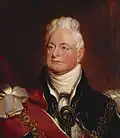Monarchy of Australia
The monarchy of Australia is Australia's form of government, embodied by the Australian sovereign and head of state. The Australian monarchy is a constitutional one, modelled on the Westminster system of parliamentary government, while incorporating features unique to the constitution of Australia.
| King of Australia | |
|---|---|
Federal | |
 | |
| Incumbent | |
.jpg.webp) | |
| Charles III since 8 September 2022 | |
| Details | |
| Style | His Majesty |
| Heir apparent | William, Prince of Wales |
| Residence | Government House, Canberra |
| This article is part of a series on the |
| Politics of Australia |
|---|
 |
| Constitution |
The present monarch is Charles III, styled King of Australia,[1] who has reigned since 8 September 2022.[n 1] The King is represented federally by the governor-general, in accordance with the Australian constitution[4] and letters patent from his mother and monarchical predecessor, Queen Elizabeth II.[5][6] Similarly, in each of the Australian states, the monarch is represented by a governor (assisted by a lieutenant-governor), according to the state constitutions. The King appoints the governor-general and governors on the advice of the respective state and federal executive councils. These are now almost the only constitutional functions of the monarch of Australia.[7]
Australian constitutional law provides that the person who is monarch of the United Kingdom is also the monarch of Australia.[8] This is understood today to constitute a separate Australian monarchy, the monarch acting with regard to Australian affairs exclusively upon the advice of Australian ministers. Australia is one of the Commonwealth realms, 15 independent countries that share the same person as monarch and head of state.
International and domestic aspects
The monarch of Australia is the same person as the monarch of the 14 other Commonwealth realms within the 56-member Commonwealth of Nations. However, each realm is independent of the others, the monarchy in each being distinct from the rest.[9][10] Effective with the Australia Act 1986, no foreign government can advise the monarch on any matters pertinent to Australia; on all matters of the Australian Commonwealth, the monarch is advised solely by Australian federal ministers of state.[11] Likewise, on all matters relating to any Australian state, the monarch is advised by the ministers of that state. The High Court of Australia held in the 1999 case Sue v Hill that, at least since the Australia Act 1986, the United Kingdom has been a foreign power in regard to Australia's domestic and foreign affairs.[n 2][10][15]
Title
The title of the monarch is Charles the Third, by the Grace of God King of Australia and His other Realms and Territories, Head of the Commonwealth.[1][16]
Prior to 1953, the title had simply been the same as that in the United Kingdom. A change in the title resulted from occasional discussion among Commonwealth prime ministers and an eventual meeting in London in December 1952, at which Australia's officials stated their preference for a format for Queen Elizabeth II's title that would name all the realms. However, they stated they would also accept Elizabeth II (by the Grace of God) of the United Kingdom of Great Britain and Northern Ireland, [name of realm], and all of her other Realms and Territories Queen, Head of the Commonwealth (Defender of the Faith).[17][18] The latter composition was adopted, despite some objections from the South African and Canadian governments. The sovereign's title in all her realms thus kept mention of the United Kingdom, but, for the first time, also separately mentioned Australia and the other Commonwealth realms. The passage of a new Royal Style and Titles Act by the Parliament of Australia put these recommendations into law.[19]
It was proposed by the Cabinet headed by Gough Whitlam that the title be amended to "denote the precedence of Australia, the equality of the United Kingdom and each other sovereign nation under the Crown, and the separation of church and state." A new Royal Titles and Styles Bill that removed specific reference to the monarch's role as Queen of the United Kingdom was passed by the federal Parliament. However, the Governor-General, Sir Paul Hasluck, reserved royal assent for the Queen, as Governor-General Sir William McKell had done with the 1953 Royal Titles and Styles Bill. Queen Elizabeth II gave her assent at Government House in Canberra on 19 October 1973.[1]
Succession
.png.webp)
Royal succession is according to British laws that have been incorporated into Australian law, both federal and state: namely, the Bill of Rights 1689 and the Act of Settlement 1701. These acts limit the succession to the natural (i.e. non-adopted), legitimate descendants of Sophia, Electress of Hanover, and stipulate that the monarch must be in communion with the Church of England upon ascending the throne. By the Parliament of Australia enacting the Statute of Westminster in 1942, Australia agreed to change its rules of succession only in agreement with the United Kingdom and the other then-Dominions.[20]
In that spirit, the Commonwealth realms reached the Perth Agreement in 2011, committed all to amend the laws governing line of succession to follow absolute primogeniture for those in the royal family born in and after 2011. As part of the agreement, Australia, along with the other realms, repealed the Royal Marriages Act 1772, which gave precedence to male heirs and excluded from succession a person married to a Roman Catholic. In Australia, federal legislation to do this required a request and concurrence from all the states,[21] meaning the federal legislation was not passed until 24 March 2015[22][23] and took effect on 26 March 2015.[24]
Upon a demise of the Crown (the death or abdication of a sovereign), it is customary for the accession of the new monarch to be publicly proclaimed by the governor-general on behalf of the Federal Executive Council, which meets at Government House after the accession. Parallel proclamations are made by the governors in each state.[25] Regardless of any proclamations, the late sovereign's heir immediately and automatically succeeds, without any need for confirmation or further ceremony. Following an appropriate period of mourning, the monarch is also crowned in the United Kingdom; though, this ritual is not necessary for a sovereign to reign. For example, Edward VIII was never crowned, yet was undoubtedly king during his short time on the throne. After an individual ascends the throne, he or she typically continues to reign until death. There is no provision in the law for a monarch to unilaterally abdicate; the only Australian monarch to abdicate, Edward VIII, did so with the agreement of the United Kingdom and the Dominions, including Australia.[26]
Finances
In 2018, a trip by Charles, then Prince of Wales, to the Commonwealth country of Vanuatu, escorted by Australian Minister for Foreign Affairs Julie Bishop in between a tour of Queensland and the Northern Territory, was paid for by the Australian government.[27]
Residences

The governor-general has two official residences: Government House in Canberra (commonly known as Yarralumla) and Admiralty House in Sydney. The Australian monarch stays at Government House when in Canberra, as do visiting heads of state.[28]
When HMY Britannia was in Australian waters and in use by the monarch of Australia, it was not available to British officials for meetings or promotions.[29]
Personification of the state
The monarch is the locus of oaths of allegiance. Many employees of the Crown are required by law to recite this oath before taking their posts, such as all members of the Commonwealth Parliament and of the state and territorial parliaments, as well as all magistrates, judges, police officers, and justices of the peace. This is in reciprocation to the sovereign's Coronation Oath, wherein he or she promises "to govern the Peoples of... Australia... according to their respective laws and customs".[30]
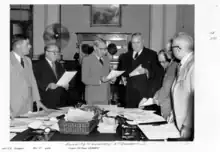
New appointees to the Federal Cabinet also swear an oath that includes allegiance to the monarch.[31] However, as this oath is not written in law, it has not always been observed and depends on the form chosen by the prime minister of the time, suggested to the governor-general. In December 2007, Kevin Rudd did not swear allegiance to the sovereign when sworn in by the Governor-General. However, he did swear allegiance to the Queen when sworn in by the Governor-General as a parliamentarian.
The Oath of Citizenship similarly contained a statement of allegiance to the reigning monarch until 1994, when a pledge of allegiance to "Australia" and its values was introduced. The High Court found in 2002, though, that allegiance to the monarch of Australia was the "fundamental criterion of membership" in the Australian body politic, from a constitutional, rather than statutory, point of view.[14]
Head of state

Key features of Australia's system of government include its basis on a combination of written and unwritten rules, comprising the sovereign, governors, and governor-general.[32] The constitution does not mention the term head of state.[33] According to the Australian Parliamentary Library, Australia's head of state is the monarch and its head of government is the prime minister, with powers limited by both law and convention for government to be carried on democratically.[34] The leading textbook on Australian constitutional law formulates the position thus: "The Queen, as represented in Australia by the governor-general, is Australia's head of state."[35]
While current official sources use the description head of state for the monarch, in the lead up to the referendum on Australia becoming a republic in 1999, David Smith proposed an alternative explanation that the governor-general is head of state. This view has some support within the group Australians for Constitutional Monarchy.[36] It is designed to counter the objections by republicans, such as the Australian Republic Movement, that no Australian can become, or can be involved in choosing, Australia's head of state.[37]
Constitutional role and royal prerogative
We have a very good system now in terms of political stability... one of the reasons why we have had this wonderful stability is because of the constitutional linkages from Crown to governor-general to prime minister at the federal level, and Crown to governor to premiers at the state level. There are checks and balances in the system and that is why we never had civil wars, that is why we never had huge political upheavals, except in '32 and '75. So the system as it is has worked very well.[38]
Australia has a written constitution based on the Westminster model of government, with some federal elements and a distinct separation of powers. It gives Australia a parliamentary system of government, wherein the role of the sovereign and governor-general is both legal and practical. The sovereign of Australia is represented in the federal sphere by the governor-general—appointed by the monarch on the advice of the prime minister of Australia—and in each state by a governor—appointed by the monarch upon the advice of the relevant state premier.
Executive
In Australia's constitutional system, one of the main duties of the governor-general is to appoint a prime minister. This is, in accordance with convention, the individual most likely to maintain the support of the House of Representatives; usually the leader of the political party with a majority in that house; but, also when no party or coalition holds a majority (referred to as a minority government situation) or other scenarios in which the governor-general's judgement about the most suitable candidate for prime minister has to be brought into play.[39] The governor-general also, on the advice of the prime minister, appoints to Cabinet the other ministers of state, who are, in turn, accountable to the Parliament and, through it, to the people. The King is informed by his governor-general of the acceptance of the resignation of a prime minister and the swearing-in of a new prime minister and other members of the ministry and he holds audience with his Australian ministers where possible.[40]
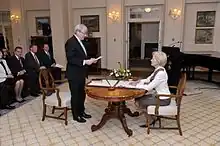
The prime minister and Cabinet advises the governor-general on how to execute his or her executive powers over all aspects of government operations and foreign affairs. This means ministers direct the use of the royal prerogative that resides in the monarch, which includes the privilege to declare war, maintain peace, direct the actions of the Australian Defence Force, and negotiate and ratify treaties, alliances, and international agreements.[41] The governor-general is empowered by the constitution to summon and prorogue parliament and call elections. Use of the royal prerogative does not require parliamentary approval.[42]
As such, the monarch's and the governor-general's roles are primarily symbolic and cultural, acting as a symbol of the legal authority under which all governments and agencies operate. Still, the royal prerogative belongs to the Crown, not to any of the ministers, and the governor-general may unilaterally use these powers in exceptional situations,[43] such as when, during the constitutional crisis in 1975, Sir John Kerr dismissed Prime Minister Gough Whitlam, on the occasion of a stalemate over government funding between the House of Representatives and the Senate.
There are also a few duties which must be specifically performed by the monarch. These include signing the appointment papers of governors-general, the confirmation of the creation of awards of Australian honours,[44][45] and the approval of any change in their Australian title.
Members of various executive agencies and other officials are appointed by the governor-general, including High Court judges. Ministers and parliamentary secretaries are also appointed to the federal Executive Council. Public inquiries are also commissioned by the Crown through a royal warrant and are called royal commissions. A casual vacancy in the Senate is filled by an appointee from the same political party by a state parliament or state governor.
Parliament

The sovereign, along with the Senate and the House of Representatives, being one of the three components of Parliament, is called the King-in-Parliament. The authority of the Crown therein is embodied in the mace (House of Representatives) and Black Rod (Senate), which both bear a crown at their apex. The monarch and viceroy do not, however, participate in the legislative process save for the granting of royal assent by the governor-general. Further, the constitution outlines that the governor-general alone is responsible for summoning, proroguing, and dissolving parliament.[46]
All laws in Australia, except in the Australian Capital Territory (ACT) Legislative Assembly, are enacted only with the granting of royal assent, done by the governor-general, relevant state governor, or Administrator in the case of the Northern Territory (NT), with the Great Seal of Australia or the appropriate state or territory seal. Laws passed by the ACT and NT legislatures, unlike their state counterparts, are subject to the oversight of the government of Australia and can be disallowed by the Australian Parliament. The governor-general may reserve a bill "for the King's pleasure"; that is withhold his consent to the bill and present it to the sovereign for their personal decision. Under the constitution, the sovereign also has the power to disallow a bill within one year of the governor-general having granted royal assent.[47]
Courts
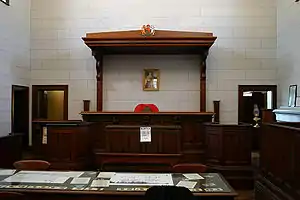
In Australia, the sovereign is deemed the fount of justice.[48][49][50] However, he does not personally rule in judicial cases,[48] meaning that judicial functions are normally performed only in the monarch's name. Criminal offences are legally deemed to be offences against the sovereign and proceedings for indictable offences are brought in the sovereign's name in the form of The King against [Name] (sometimes also referred to as the Crown against [Name]).[51][52] Hence, the common law holds that the sovereign "can do no wrong"; the monarch cannot be prosecuted in his or her own courts for criminal offences. Civil lawsuits against the Crown in its public capacity (that is, lawsuits against the government) are permitted; however, lawsuits against the monarch personally are not cognisable. In international cases, as a sovereign and under established principles of international law, the king of Australia is not subject to suit in foreign courts without his express consent. The prerogative of mercy lies with the monarch, and is exercised in the state jurisdictions by the governors.[53]
States and territories
In accordance with the Australia Act 1986, the sovereign has the power to appoint, on the advice of the relevant state premier, a governor in each of the Australian states, who themselves appoint executive bodies, as well as people to fill casual Senate vacancies, if the relevant state parliament is not in session. The state governors continue to serve as the direct representatives of the King, in no way subordinate to the governor-general, and they carry out on her behalf all of the King's constitutional and ceremonial duties in respect of their respective state. The Northern Territory and the Australian Capital Territory resemble states in many respects, but are administered directly by the Commonwealth of Australia; an administrator, appointed by the governor-general upon the advice of the Commonwealth government, takes the place of a state governor in the Northern Territory. The Australian Capital Territory has no equivalent position.
Cultural role
Royal presence and duties
.jpg.webp)
Official duties involve the sovereign representing the state at home or abroad, or other royal family members participating in a government-organised ceremony either in Australia or elsewhere.[54] The sovereign and/or his or her family have participated in events such as various centennials and bicentennials; Australia Day; the openings of Olympic and other games; award ceremonies; D-Day commemorations; anniversaries of the monarch's accession; and the like.
Other royals have participated in Australian ceremonies or undertaken duties abroad, such as Prince Charles at the Anzac Day ceremonies at Gallipoli, or when the Queen, Prince Charles, and Princess Anne participated in Australian ceremonies for the anniversary of D-Day in France in 2004. Members of the royal family will sometimes make private donations to Australian charities or causes, such as when Queen Elizabeth II made a private donation to the Australian Red Cross Appeal after the Blue Mountains bushfires in 2009.[55]
The Crown and the Australian Defence Force

Section 68 of the Australian Constitution says: "The command in chief of the naval and military forces of the Commonwealth is vested in the governor-general as the Queen's (monarch's) representative." In practice, however, the governor-general does not play any part in the ADF's command structure other than following the advice of the Minister for Defence in the normal form of executive government.[56]
Australian naval vessels bear the prefix His Majesty's Australian Ship (HMAS) and many regiments carry the "royal" prefix.[57]
Members of the royal family have presided over military ceremonies, including Trooping the Colour ceremonies, inspections of the troops, and anniversaries of key battles. When the Queen was in Canberra, she laid wreaths at the Australian War Memorial. In 2003, the Queen acted in her capacity as Australian monarch when she dedicated the Australian War Memorial in Hyde Park, London.
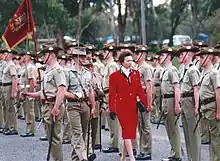
Some members of the royal family are Colonels-in-Chief of Australian regiments, including: the Royal Regiment of Australian Artillery; Royal Australian Army Medical Corps; the Royal Australian Armoured Corps and the Royal Australian Corps of Signals, amongst many others. The Queen's late husband, the Duke of Edinburgh, was an Admiral of the Fleet.[58]
Australian royal symbols
Royal symbols are the visual and auditory identifiers of the Australian monarchy. The main symbol of the monarchy is the sovereign, and their image is used to signify Australian sovereignty. Queen Elizabeth II's portrait, for instance, currently appears on all Australian coins,[59] the five-dollar banknote,[60] and postage stamps such as the Queen's Birthday stamp, issued by Australia Post every year since 1980.[61] A Crown is depicted as a royal symbol that appears on the Australian coat of arms,[62] and on various medals and awards.[63] The latter reflects the monarch's place as the fount of honour—the formal head of the Australian honours and awards system.[64][65]
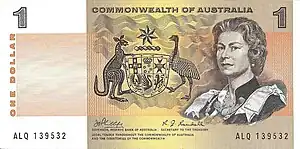
The sovereign is further both mentioned in and the subject of songs and loyal toasts.[66] Australia inherited the royal anthem "God Save the King" (alternatively, "God Save the Queen" in the reign of a female monarch) from the United Kingdom. It was the national anthem of Australia until 1984, and has since been retained as the country's royal anthem, its use generally restricted to official occasions where the monarch or a member of the royal family is present.[67][68]
.svg.png.webp)
The Queen's Personal Australian Flag, adopted in 1962, was used to signify Queen Elizabeth II's presence when she visited Australia. It features the coat of arms of Australia in banner form, defaced with a gold seven-pointed federation star with a blue disc containing the crowned letter E, surrounded by a garland of golden roses.[69] Each of the six sections of the flag represents the heraldic badge of the Australian states, and the whole is surrounded by an ermine border representing the federation of the states.[70] The current monarch, King Charles III, has not adopted a personal flag for Australia.
As in other Commonwealth realms, the King's Official Birthday is a public holiday and, in Australia, is observed on the second Monday in June in all states and territories, except Queensland and Western Australia. In Queensland, it is celebrated on the first Monday in October, and in Western Australia it is usually the last Monday of September or the first Monday of October.[71] Celebrations are mainly official, including the Australian Birthday Honours list and military ceremonies.[72][73]
Religious role
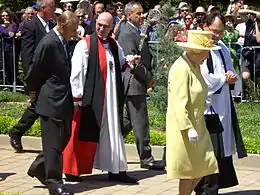
Until its new constitution went into force in 1962, the Anglican Church of Australia was part of the Church of England. Its titular head was consequently the monarch, in his or her capacity as Supreme Governor of the Church of England.[74] However, unlike in England, Anglicanism was never established as a state religion in Australia.[75]
History
The development of a distinctly Australian monarchy came about through a complex set of incremental events, beginning in 1770, when Captain James Cook, in the name of, and under instruction from, King George III, claimed the east coast of Australia.[76] Colonies were eventually founded across the continent,[77][78] all of them ruled by the monarch of the United Kingdom, upon the advice of his or her British ministers, the Secretary of State for the Colonies, in particular. After Queen Victoria's granting of royal assent to the Commonwealth of Australia Constitution Act on 9 July 1900, which brought about Federation in 1901, whereupon the six colonies became the states of Australia, the relationship between the state governments and the Crown remained as it was pre-1901: References in the constitution to "the Queen" meant the government of the United Kingdom (in the formation of which Australians had no say)[11] and the Colonial Laws Validity Act 1865 – by which colonial laws deemed repugnant to imperial (British) law in force in the colony were rendered void and inoperative – remained in force in both the federal and state spheres;[79] and all the governors, both of the Commonwealth and the states, remained appointees of the British monarch on the advice of the British Cabinet,[80] a situation that continued even after Australia was recognised as a Dominion of the British Empire in 1907.[81]
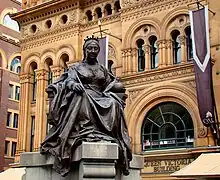
In response to calls from some Dominions for a re-evaluation in their status under the Crown after their sacrifice and performance in the First World War,[35]: 110 a series of Imperial Conferences was held in London, from 1917 on, which resulted in the Balfour Declaration of 1926, which provided that the United Kingdom and the Dominions were to be considered as "autonomous communities within the British Empire, equal in status, in no way subordinate to one another in any aspect of their domestic or external affairs, though united by a common allegiance to the Crown." The Royal and Parliamentary Titles Act 1927, an Act of the Westminster Parliament, was the first indication of a shift in the law, before the Imperial Conference of 1930 established that the Australian Cabinet could advise the sovereign directly on the choice of governor-general, which ensured the independence of the office.[82] The Crown was further separated amongst its dominions by the Statute of Westminster 1931,[83] and, though it was not adopted by Australia until 1942 (retroactive to 3 September 1939).[84]
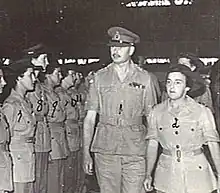
The Curtin Labor government appointed Prince Henry, Duke of Gloucester, as governor-general during the Second World War. Curtin hoped the appointment might influence the British to despatch men and equipment to the Pacific War, and the selection of the brother of King George VI reaffirmed the important role of the Crown to the Australian nation at that time.[85] The Queen became the first reigning monarch to visit Australia in 1954, greeted by huge crowds across the nation. In 1967, the Queen's son, Charles III (then Prince Charles), attended school in Geelong Grammar School in Corio, Victoria.[86] Her grandson Prince Harry undertook a portion of his gap-year living and working in Australia in 2003.[87]
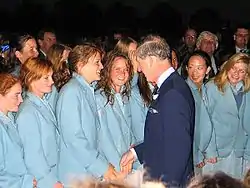
The sovereign did not possess a title unique to Australia until the Australian Parliament enacted the Royal Styles and Titles Act in 1953,[19] after the accession of Elizabeth to the throne, and giving her the title of Queen of the United Kingdom, Australia and Her other Realms and Territories. Still, Elizabeth remained both as a queen who reigned in Australia both as Queen of Australia (in the federal jurisdiction) and Queen of the United Kingdom (in each of the states), as a result of the states not wishing to have the Statute of Westminster apply to them, believing that the status quo better protected their sovereign interests against an expansionist federal government, which left the Colonial Laws Validity Act in effect. Thus, the British government could still – at least in theory, if not with some difficulty in practice – legislate for the Australian states, and the viceroys in the states were appointed by and represented the sovereign of the United Kingdom, not that of Australia;[88] as late as 1976, the British ministry advised the Queen to reject Colin Hannah as the nominee of the Queensland Cabinet for governor,[89] and court cases from Australian states could be appealed directly to the Judicial Committee of the Privy Council in London, thereby bypassing the Australian High Court. In 1973 reference to the United Kingdom was removed by the Royal Style and Titles Act. Henceforth, the monarch would be styled uniquely as 'Queen of Australia'. The Queen signed her assent to the Act at Government House, Canberra that year, leading Senior Vice President of the Labor Party, Jack Egerton, to remark to her, "They tell me, love, you've been naturalised."[90][91] It was with the passage of the Australia Act in 1986, which repealed the Colonial Laws Validity Act and abolished appeals of state cases to London, that the final vestiges of the British monarchy in Australia were removed, leaving a distinct Australian monarchy for the nation. The view in the Republic Advisory Committee's report in 1993 was that if, in 1901, Victoria, as Queen-Empress, symbolised the British Empire of which all Australians were subjects, all of the powers vested in the monarch under Australia's Constitution were now exercised on the advice of the Australian government.[11]
It is my duty to seek to remain true to the interests of Australia and all Australians as we enter the 21st century. That is my duty. It is also my privilege and my pleasure. I cannot forget that I was on my way to Australia when my father died. Since then, and since I first stepped ashore here in Sydney in February 1954, I have felt part of this rugged, honest, creative land. I have shared in the joys and the sorrows, the challenges and the changes that have shaped this country's history over these past 50 years.[92][93]
Elizabeth II, Queen of Australia, 2000
The 1999 Australian republic referendum was defeated by 54.4 per cent of the populace, despite polls showing that the majority supported becoming a republic.[94] It is believed the proposed model of the republic (not having a directly elected president) was unsatisfactory to most Australians.[95] The referendum followed the recommendation of a 1998 Constitutional Convention called to discuss the issue of Australia becoming a republic.
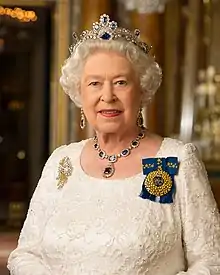
Elizabeth II died on 8 September 2022. She was the longest serving monarch and was succeeded by her son, Charles III. The coronation of Charles III and Camilla took place on 6 May 2023.
Debate
Whereas Prime Minister Julia Gillard stated that she would like to see Australia become a republic, she, on 21 October 2011, at a reception in the presence of the Queen at Parliament House, asserted that the monarch is "a vital constitutional part of Australian democracy and would only ever be welcomed as a beloved and respected friend."[96] After Kevin Rudd was appointed as prime minister, he affirmed that a republic was still a part of his party's platform and stated his belief that the debate on constitutional change should continue.[97]
A Morgan poll taken in October 2011 found that support for constitutional change was at its lowest for 20 years. Of those surveyed, 34 per cent were for a republic, as opposed to 55 per cent preferring to maintain the current constitutional arrangements.[98] A peer-reviewed study published in the Australian Journal of Political Science in 2016 found that there had been a significant increase to support for monarchy in Australia after a 20-year rapid decline following the 1992 annus horribilis.[99]
A poll in November 2018 found support for the monarchy had climbed to its highest point in 25 years.[100] A YouGov poll in July 2020 found that 62 per cent of respondents supported replacing the monarch with "an Australian head of state".[101] A 2021 Ipsos poll found 40 per cent of respondents were opposed to Australia becoming a republic, 34 per cent were in favour, and 26 per cent didn't know. This was the lowest support recorded for republicanism since 1979.[102]
Gillard had, during her time as prime minister, propounded that an appropriate time for Australia to become a republic would be after the end of the reign of Queen Elizabeth II. Following Elizabeth's death, the Prime Minister, Anthony Albanese, said in an interview he wanted to Australia to have an appointed head of state, but he did not have a timetable for a referendum, did not commit to advising one take place during his time as prime minister, and postulated that no vote should happen until demand rose from the grassroots.[103] Albanese had earlier claimed he would, out of respect for the Queen, merely refrain from having the governor-general call a referendum before the next election for the House of Representatives.[104][105]
Republicans have dismissed the large public turnouts during royal tours as "the cult of celebrity".[106] However, following Prince William's and Catherine's visit to the Blue Mountains after devastating bush fires in 2014, historian Jane Connors opined that "there is still a sense that having the royal family come to see you is more healing and significant than just having anyone come to see you", citing comments made by some who had come to the area while the royal couple were present.[107]
The idea of a uniquely Australian monarch, resident in Australia, has been voiced occasionally. The proposition was first published in 1867.[108] It was later reiterated by Alan Atkinson in his 1993 book The Muddle Headed Republic,[109] by Harry Meklonian in 2009,[110] and by Richard Hughes in 2017.[111] A possibility would be to crown someone in the line of succession to the Australian throne, but who is not expected to become monarch by the present rules of succession.[112] This possibility is not seriously discussed by either contemporary Australian monarchists or republicans.[110]
List of monarchs of Australia
Frank C. Green, the Clerk of the House of Representatives, noted in 1955 that, while the Australian parliament did not then have a provision for foreign dignitaries to address the legislative body, Prince Edward and Prince Albert had been allowed to make speeches to parliamentarians in 1920 and 1927, respectively, as "the British royal family is also the Australian royal family."[113] Australian legislators later spoke in parliament of the Australian royal family[114][115] and John Mason, who acted as the British high commmissioner to Australia between 1980 and 1984, referred to Queen Elizabeth II and her relations as the Australian royal family.[29] However, Prime Minister Anthony Albanese stated in 2023 that "we [Australians] don't have an Australian royal family".[103]
Colonial period (1770–1901)
British crown (1901–1939)
| Portrait | Regnal name (Birth–Death) Royal dynasty |
Reign | Full name | Consort | |
|---|---|---|---|---|---|
| Start | End | ||||
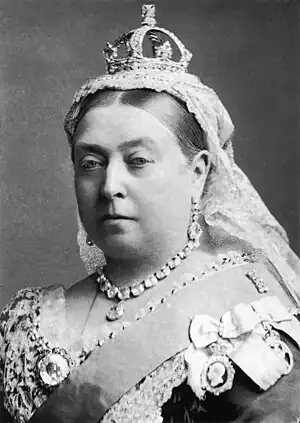 |
Victoria (1819–1901) House of Hanover |
1 January 1901 | 22 January 1901 | Alexandrina Victoria | Widowed |
| Governor-general: John Hope, 7th Earl of Hopetoun | |||||
| Prime minister: Edmund Barton | |||||
 |
Edward VII (1841–1910) House of Saxe-Coburg and Gotha |
22 January 1901 | 6 May 1910 | Albert Edward | Alexandra of Denmark |
| Governors-general: John Hope, 7th Earl of Hopetoun, Hallam Tennyson, 2nd Baron Tennyson, Henry Northcote, 1st Baron Northcote, William Ward, 2nd Earl of Dudley | |||||
| Prime ministers: Edmund Barton, Alfred Deakin, Chris Watson, George Reid, Alfred Deakin, Andrew Fisher, Alfred Deakin | |||||
.jpg.webp) |
George V (1865–1936) House of Saxe-Coburg and Gotha (until 1917) House of Windsor (after 1917) |
6 May 1910 | 20 January 1936 | George Frederick Ernest Albert | Mary of Teck |
| Governors-general: William Ward, 2nd Earl of Dudley, Thomas Denman, 3rd Baron Denman, Sir Ronald Ferguson, Henry Forster, 1st Baron Forster, John Baird, 1st Baron Stonehaven, Sir Isaac Isaacs | |||||
| Prime ministers: Andrew Fisher, Joseph Cook, Andrew Fisher, Billy Hughes, Stanley Bruce, James Scullin, Joseph Lyons | |||||
 |
Edward VIII (1894–1972) House of Windsor |
20 January 1936 | 11 December 1936 | Edward Albert Christian George Andrew Patrick David | None |
| Governors-general: Sir Isaac Alfred Isaacs, Alexander Hore-Ruthven, 1st Earl of Gowrie | |||||
| Prime minister: Joseph Lyons | |||||
.jpg.webp) |
George VI (1895–1952) House of Windsor |
11 December 1936 | 3 September 1939 | Albert Frederick Arthur George | Elizabeth Bowes-Lyon |
| Governors-general: Alexander Hore-Ruthven, 1st Earl of Gowrie | |||||
| Prime ministers: Joseph Lyons, Sir Earle Page, Robert Menzies | |||||
The Australian Crown (1939–present)
In 1939, the Australian Crown emerged as an independent entity from that of the British Crown due to the Statute of Westminster Adoption Act 1942 (retroactive to 3 September 1939).
| Portrait | Regnal name (Birth–Death) Royal dynasty |
Reign | Full name | Consort | |
|---|---|---|---|---|---|
| Start | End | ||||
.jpg.webp) |
George VI (1895–1952) House of Windsor |
3 September 1939 | 6 February 1952 | Albert Frederick Arthur George | Elizabeth Bowes-Lyon |
| Governors-general: Alexander Hore-Ruthven, 1st Earl of Gowrie, Prince Henry, Duke of Gloucester, Sir William McKell | |||||
| Prime ministers: Robert Menzies, Arthur Fadden, John Curtin, Frank Forde, Ben Chifley, Robert Menzies | |||||
 |
Elizabeth II (1926–2022) House of Windsor |
6 February 1952 | 8 September 2022 | Elizabeth Alexandra Mary | Philip Mountbatten |
| Governors-general: Sir William McKell, Sir William Slim, William Morrison, 1st Viscount Dunrossil, William Sidney, 1st Viscount De L'Isle, Richard Casey, Baron Casey, Sir Paul Hasluck, Sir John Kerr, Sir Zelman Cowen, Sir Ninian Stephen, William Hayden, Sir William Deane, Peter Hollingworth, Michael Jeffery, Dame Quentin Bryce, Sir Peter Cosgrove, David Hurley | |||||
| Prime ministers: Sir Robert Menzies, Harold Holt, John McEwen, John Gorton, William McMahon, Gough Whitlam, Malcolm Fraser, Bob Hawke, Paul Keating, John Howard, Kevin Rudd, Julia Gillard, Kevin Rudd, Tony Abbott, Malcolm Turnbull, Scott Morrison, Anthony Albanese | |||||
.jpg.webp) |
Charles III (born 1948) House of Windsor |
8 September 2022 | Present | Charles Philip Arthur George | Camilla Shand |
| Governors-general: David Hurley | |||||
| Prime ministers: Anthony Albanese | |||||
Timeline of monarchs since Federation

See also
Notes
- Queen Elizabeth died at 3:10pm 8 September in Balmoral, UK which would have been 9 September in some Australian states.[2] The Australian government acknowledges King Charles III's accession day as the day he became king in the United Kingdom, 8 September.[3]
- It followed that a British citizen was a citizen of a foreign nation and incapable of being a member of the Australian Parliament, pursuant to Section 44(i) of the Australian constitution. In 2001, the High Court ruled that, until the United Kingdom became a foreign power, all British subjects were subjects of the monarch in right of the United Kingdom and thus could not be classified as aliens within the meaning of Section 51(xix) of the constitution.[12][13][14]
References
- "Royal Style and Titles Act 1973 (Cth)". Museum of Australian Democracy. Retrieved 3 November 2015.
- "The day Queen Elizabeth died: the inside story of her final hours". The Guardian. Retrieved 16 June 2023.
- "Her Majesty The Queen". www.pmc.gov.au. Australian Department of the Prime Minister and Cabinet. Retrieved 4 November 2022.
- Constitution section 2.
- Letters Patent Relating to the Office of Governor‑General of the Commonwealth of Australia, 21 August 2008 "Office of Governor-General of the Commonwealth of Australia – 21/08/2008". Archived from the original on 14 July 2022. Retrieved 8 April 2023.
- Governor-General's Commission Archived 2022-11-08 at the Wayback Machine
- Williams, George; Brennan, Sean; Lynch, Andrew (2014). Blackshield and Williams Australian Constitutional Law and Theory (6 ed.). Annandale, NSW: Federation Press. pp. 352–65. ISBN 978-1-86287-918-8.
- This is the effect of covering clause 2 of "Commonwealth of Australia Act 1900 (UK)". Federal Register of Legislation. "The provisions of this Act referring to the Queen shall extend to Her Majesty's heirs and successors in the sovereignty of the United Kingdom". The act contains the Constitution of Australia.
- Trepanier, Peter (2004). "Some Visual Aspects of the Monarchical Tradition" (PDF). Canadian Parliamentary Review. Ottawa: Commonwealth Parliamentary Association. 27 (2): 28. Retrieved 21 July 2020.
- Sue v Hill [1999] HCA 30, (1999) 199 CLR 462 (23 June 1999), High Court (Australia)
- Report of the Republic Advisory Committee, Commonwealth Government Printer, Canberra, 1993, p29-30
- Constitution (Cth) s 51.
- Re Patterson; Ex parte Taylor [2001] HCA 51, (2001) 207 CLR 391, High Court (Australia).
- Prince, P. "We are Australian-The Constitution and Deportation of Australian-born Children". Research Paper no. 3 2003/04. Australian Parliamentary Library. Archived from the original on 16 November 2016.
- Twomey, Anne (2000). "Sue v Hill – The Evolution of Australian Independence". In Stone, Adrienne; Williams, George (eds.). The High Court at the crossroads: essays in constitutional law. New South Wales, Australia: Federation Press. ISBN 978-1-86287-371-1.
- "What is The King's title in Australia?". Department of Prime Minister and Cabinet. Retrieved 1 June 2023.
- Twomey, Anne (2006). The Chameleon Crown. Sydney, NSW: Federation Press. pp. 106–107. ISBN 9781862876293.
- "Documents on Canadian External Relations; Volume No. 18 – 2; Chapter 1, Part 2, Royal Style and Titles". Archived from the original on 16 September 2004.
- Royal Style and Titles Act 1953 (Cth).
- "Statute of Westminster Adoption Act 1942 – The Schedule". Commonwealth Consolidated Acts. AustLII. Retrieved 14 May 2023.
- Constitution (Cth) s 51(xxxviii); the Northern Territory added its request and concurrence, although this was not constitutionally required.
- Succession to the Crown Act 2015 (Cth) Archived 2 February 2016 at the Wayback Machine, ComLaw.
- Succession to the Crown Commencement Proclamation 2015 (Cth) Archived 2 February 2016 at the Wayback Machine, ComLaw
- "Written statements - Written questions, answers and statements - UK Parliament". Archived from the original on 5 July 2016.
- Greg Taylor (2006), The Constitution of Victoria, Sydney: Federation Press, p. 69
- Constitution (Cth) s 15 Casual vacancies.
- Davidson, Helen (7 April 2018). "Royal visit flight costs could top $100,000 for Australian taxpayers". The Guardian. Retrieved 9 April 2018.
- "The Governor-General's Official residences". The Governor-General of the Commonwealth of Australia. Retrieved 28 August 2021.
- Mason, John (1998), Diplomatic Despatches, Canberra: National Library of Australia, p. 179, ISBN 9780642107978
- The Form and Order of Service that is to be performed and the Ceremonies that are to be observed in the Coronation of Her Majesty Queen Elizabeth II in the Abbey Church of St. Peter, Westminster, on Tuesday, the second day of June 1953 Archived 7 October 2016 at the Wayback Machine. Oremus.org (11 April 1994).
- "Oaths and affirmations made by the executive and members of federal Parliament since 1901". Parliament of Australia. 3 June 2013. Retrieved 18 September 2013.
- Government and Politics in Australia, 10th edition, by Alan Fenna and others, P.Ed Australia, 2013. Chapter 2, headnote, p.12 and Note 2 p.29.
- Constitution (Cth) s 2. Section 2 refers to "the Queen" (at the time, Queen Victoria) and covering clause 2 requires that to be interpreted as referring eventually to whoever of her "heirs and successors" is "in the sovereignty", i.e. is the monarch, of the United Kingdom.
- "Infosheet 20 - The Australian system of government". www.aph.gov.au. Archived from the original on 20 December 2016.
- Williams, George; Brennan, Sean & Lynch, Andrew (2014). Blackshield and Williams Australian Constitutional Law and Theory (6 ed.). Leichhardt, NSW: Federation Press. p. 2. ISBN 978-1-86287-918-8.
- Australia's Head of State, Australians for Constitutional Monarchy, Accessed=1 March 2016 "Articles on Australia's Head of State - Governors & Governor-General". Archived from the original on 4 March 2016. Retrieved 29 February 2016.
- [url=http://www.republic.org.au Australian Republic Movement website]
- Governor General of the Commonwealth of Australia: Transcript – World Today with Major General Jeffery – 23 June 2003 Archived 2 June 2009 at the Wayback Machine
- Office of the Governor-General of Australia. "About the Governor-General: Governor-General's role". Australian Government Publishing Service. Archived from the original on 15 October 2012. Retrieved 16 March 2011.
- Victorian Premier John Brumby has met Queen Elizabeth II in Scotland to discuss the impact of the February bushfires. Archived 13 May 2013 at the Wayback Machine, ABC Online, 2009-10-06, Retrieved 29 October 2009
- Australian Government Department of Foreign Affairs and Trade: Negotiating and Implementing Treaties Archived 31 December 2014 at the Wayback Machine
- Australian Government Department of Foreign Affairs and Trade: Treaties, the Constitution and the National Interest Archived 31 December 2014 at the Wayback Machine
- Governor-General of Australia :: Governor-General's Role Archived 15 October 2012 at the Wayback Machine. Gg.gov.au.
- Australian Government: It's an Honour: Official Creation of Awards Archived 24 December 2016 at the Wayback Machine. Itsanhonour.gov.au (16 May 2011).
- Commonwealth of Australia Gazette; No. S 86, Monday, 30 May 2005 Archived 21 February 2007 at the Wayback Machine
- "The Australian Constitution - Section 5 - Sessions of Parliament - Prorogation and Dissolution". australianpolitics.com. Archived from the original on 11 December 2007.
- "The Australian Constitution - Section 59 - Disallowance by the Queen". australianpolitics.com. Archived from the original on 11 December 2007.
- Gibbs, Harry; "The Crown and the High Court – Celebrating the 100th birthday of the High Court of Australia"; 17 October 2003 Archived 27 April 2016 at the Wayback Machine. Norepublic.com.au (17 October 2003).
- The Queen as Fount of Justice. Royal.gov.uk (17 December 2013). Archived 17 December 2013 at the Wayback Machine
- High Court, Australia. (1998), The Commonwealth Law Reports: Cases Determined in the High Court of Australia · Volume 191, Law Book Company of Australasia Limited, p. 268
- Essenberg v The Queen B55/1999 [2000] HCATrans 386, High Court (Australia).
- The Queen v Tang [2008] HCA 39, (2008) 237 CLR 1, High Court (Australia).
- Section 475(1) Crimes Act 1900 (ACT); ss 474B and 474C Crimes Act 1900 and s 26 Criminal Appeal Act 1912 (NSW); s 433A Criminal Code (Northern Territory); ss 669A, 672A Criminal Code 1899 (Queensland); s 369 Criminal Law Consolidation Act 1935 (South Australia); ss 398, 419 Criminal Code (Tasmania); s 584 Crimes Act 1958 (Victoria); s 21 Criminal Code and Part 19 Sentencing Act 1995 (Western Australia)
- Buckingham Palace: Guidelines and Procedures for the Acceptance, Classification, Retention and Disposal of Gifts to Members of the Royal Family. Royal.gov.uk (22 August 2012). Archived 14 February 2008 at the Wayback Machine
- The Princess Royal to visit areas affected by the Victorian bushfires. Royal.gov.uk. Archived 24 February 2009 at the Wayback Machine
- Raspal Khosa (2004). Australian Defence Almanac 2004–05. Australian Strategic Policy Institute, Canberra. Page 4.
- "RAR; the Royal Australian Regiment; a history". Archived from the original on 9 September 2010. Retrieved 22 September 2010.
- Prince Philip, Duke of Edinburgh Archived 5 March 2016 at the Wayback Machine. Mlahanas.de.
- "Heads or Tails". Royal Australian Mint. 8 January 2016. Retrieved 3 April 2022.
- "$5 Banknote". Reserve Bank of Australia. Retrieved 3 April 2022.
- "The Platinum Jubilee stamps that have met the Queen's approval". The Sydney Morning Herald. 4 April 2022.
- "Commonwealth Coat of Arms". Department of the Prime Minister and Cabinet. Retrieved 3 April 2022.
- "It's an Honour - Honours - Awards - A-Z of Awards - National Medal". 7 January 2009. Archived from the original on 7 January 2009.
- "Commonwealth Honours". The Royal Family. 12 November 2015. Retrieved 11 April 2022.
- "Fount of Honour". www.crownedrepublic.com.au. Retrieved 11 April 2022.
- "Grace and Loyal Toast". governor.nsw.gov.au. Governor of New South Wales. Retrieved 11 April 2022.
- "Australian National Anthem – History". Australian Government. 10 July 2007. Archived from the original on 6 September 2015. Retrieved 1 November 2007.
- "Australian National Anthem". Department of the Prime Minister and Cabinet. Australian Government. Retrieved 26 April 2020.
- Debrett's Handbook of Australia and New Zealand, Debrett's Peerage, 1984, p. 207, ISBN 9780949137005
- "The Australian Coat of Arms". www.anbg.gov.au.
- "Why you have bad weather and King George VI to thank for the Queen's Birthday long weekend". ABC News. 12 June 2021.
- "Is Queen's Birthday a public holiday in your state?". news.com.au. 10 June 2021.
- "Queen's Birthday Parade Returns to Duntroon". army.gov.au. 12 June 2021.
- "The Church of England Australia was organised on the basis that it was part of the Church of England, not merely 'in communion with', or 'in connection with', the Church of England. Thus any changes to doctrine or practice in England were to be applied in Australia, unless the local situation made the change inapplicable.... A new national constitution was agreed in 1961 and came into force on 1 January 1962. This created a new church, the Church of England in Australia, and severed the legal nexus with the Church of England." Outline of the Structure of the Anglican Church of Australia, p. 5.
- Part 2 – The Anglican Church in Australia Archived 8 May 2016 at the Wayback Machine, Anglican Church of Australia. Retrieved 17 January 2017.
- Queen and Commonwealth: Australia: History. Royal.gov.uk (22 August 2012). Archived 11 February 2008 at the Wayback Machine
- Day, D; Claiming a Continent; Harper Collins, 1997; p.38
- B. Hunter (ed) The Statesman's Year Book, MacMillan Press, p.102 ff.
- Craig, John; Australian Politics: A Source Book; second ed.; p.43
- W.J. Hudson and M.P. Sharp, Australian Independence, pp. 4, 90
- E.M. Andrews, The ANZAC Illusion, p.21
- David Smith, Head of State, Macleay Press 2005, p.24
- Statute of Westminster 1931 (c. 4) s. 4 Archived 4 August 2009 at the Wayback Machine; cf McInn, W.G.; A Constitutional History of Australia; p.152
- Statute of Westminster Adoption Act 1942 (Cth) s 3 Archived 3 March 2016 at the Wayback Machine Craig, John; Australian Politics: A Source Book; p.43
- Biography – first Duke of Gloucester – Australian Dictionary of Biography. Adbonline.anu.edu.au.
- Magnay, Jacquelin (27 January 2011). "Prince Charles says 'Pommy' insults were character building". The Daily Telegraph. London.
- "Prince Harry arrives for gap year in Australia". BBC News. 23 September 2003.
- Craig; p.43
- Chipp, Don; An Individual View; p.144
- "Whitlam Institute Australia the Nation". Whitlam Institute.
- "Documenting Democracy". www.foundingdocs.gov.au.
- "You decide when monarchy goes, Queen tells Australians". TheGuardian.com. 20 March 2000.
- "A speech by the Queen at the Sydney Opera House". The Royal Family. 20 March 2010.
- Newspoll polls 1995–2002, The Australian Archived 15 June 2005 at the Wayback Machine
- Paul Keating: republicanism, People and power, Power, people and politics in the post-war period, History Year 9, NSW | Online Education Home Schooling Skwirk Australia Archived 15 January 2016 at the Wayback Machine. Skwirk.com (1 January 2001).
- Speech by Prime Minister of Australia, Julia Gillard, 21 October 2011, Parliament House
- Kevin Rudd reaffirms support for republic | PerthNow Archived 11 April 2008 at the Wayback Machine. News.com.au (6 April 2008).
- "Republic floats away as royal reign lingers" by Judith Ireland, The Canberra Times, 22 October 2011.
- Mansillo, Luke (25 January 2016). "Loyal to the Crown: shifting public opinion towards the monarchy in Australia". Australian Journal of Political Science. 51 (2): 213–235. doi:10.1080/10361146.2015.1123674. S2CID 155419597.
- "Monarchy support at highest level: Poll". TheGuardian.com. 11 November 2018.
- Wood, Miranda (12 July 2020). "Poll finds majority want an Australian head of state". The Sunday Telegraph. Retrieved 12 July 2020.
- Topsfield, Jewel (25 January 2021). "'No sense of momentum': Poll finds drop in support for Australia becoming a republic". The Sydney Morning Herald. Retrieved 27 November 2021.
- Television Interview—Piers Morgan, Office of the Prime Minister of Australia, 3 May 2023, retrieved 10 May 2023
- Lynch, Cordelia (11 September 2022). "Australian PM says he will not hold republic referendum during his first term out of 'deep respect' for Queen". Sky News (UK). Retrieved 11 September 2022.
- Lynch, Cordelia (11 September 2022). "Queen dies: Australian prime minister Anthony Albanese rules out republic referendum in first term". Sky News (UK). Retrieved 11 September 2022.
- "The Queen and I (2000) - Charles Wooley's meeting with the Queen | 60 Minutes Australia". YouTube.
- "Historian Jane Connors on Royal visits to Australia". Australian Broadcasting Corporation. 10 August 2015.
- "The lost option".
- Irving, Helen (1997), "Republicanism and Citizenship", in Galligan, Brian; McAllister, Ian; Ravenhill, John (eds.), New Developments in Australian Politics, Macmillan Education Australia, p. 135, ISBN 9780732943042, retrieved 9 May 2023
- Melkonian, Harry (13 November 2009), "A novel solution to the republican debate", The Sydney Morning Herald, retrieved 9 May 2023
- Hughes, Richard (1 December 2017), "Call me old-fashioned, but Prince Harry wouldn't be a bad monarch Down Under", The Sydney Morning Herald, retrieved 9 May 2023
- Lewis, David. "Persons eligible to succeed to the British Throne as of 1 Jan 2011". wargs.com. Archived from the original on 17 May 2011.
- McLeod, Alan Lindsey (1957), A Rhetorical Study of Commonwealth Prime Ministers' Speeches to the United States Congress, 1945-55, Pittsburg: Pennsylvania State University, p. 10, retrieved 10 May 2023
- Gough Whitlam, Representative for Werriwa (5 May 1960). "Marriage of Princess Margaret". Parliamentary Debates (Hansard). Commonwealth of Australia: House of Representatives. p. 1399.
- Leslie Carrick, Senator for New South Wales (2 May 1979). "Visits by the Royal Family". Parliamentary Debates (Hansard). Commonwealth of Australia: Senate. p. 1543.
Bibliography
- Hill, David (2016). Australia and the Monarchy. Random House. ISBN 978-0857987549.
- Smith, David (2005). Head of State: the Governor-General, the Monarchy, the Republic and the Dismissal. Paddington, NSW: Macleay Press. ISBN 978-1876492151.
- Twomey, Anne (2006). The Chameleon Crown: the Queen and her Australian Governors. Annandale, NSW: Federation Press. ISBN 9781862876293.
Further information
- ^ National Archives of Australia: King George VI (1936–52)
- ^ National Museum of Australia: Royal Romance
- ^ National Archives of Australia: Royal Visit 1954
- ^ National Archives of Australia: Royal Visit 1963
- ^ National Archives of Australia: Prince Charles
- ^ Australian Government: Royal Visits to Australia
- ^ National Archives of Australia: Royalty and Australian Society
- ^ Yahoo News: Prince Edward to visit Vic fire victims
- ^ ABC News: Royal couple set for busy Aust schedule
- ^ Queen, Howard honour war dead
- ^ World leaders hail D-Day veterans
External links
- Queen's Official website on Australia
- Governor-General of Australia
- Letters Patent – 21 August 2008
- Australians for Constitutional Monarchy
- The Australian Republican Movement
- The Australian Monarchist League
.jpg.webp)
%252C_by_Thomas_Lawrence_-_Royal_Collection.jpg.webp)
